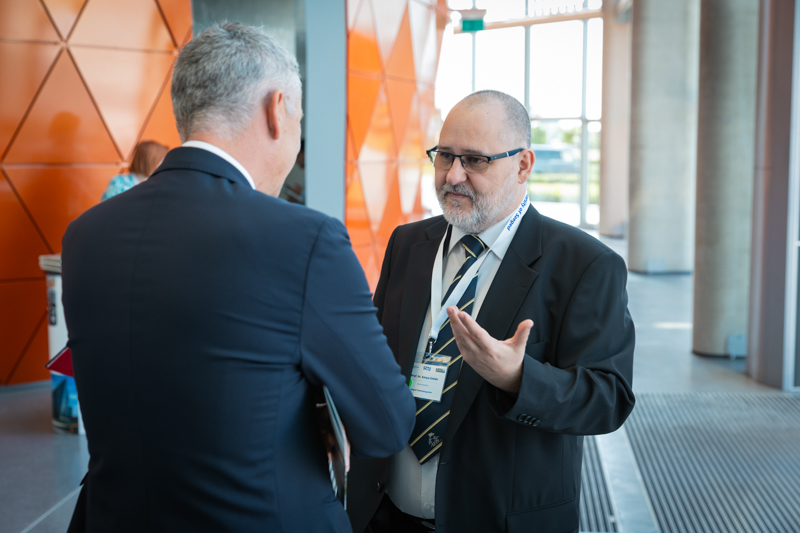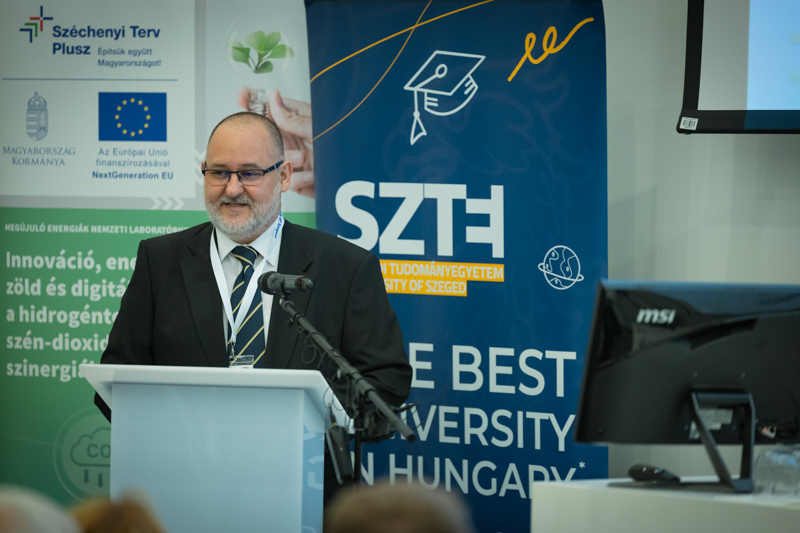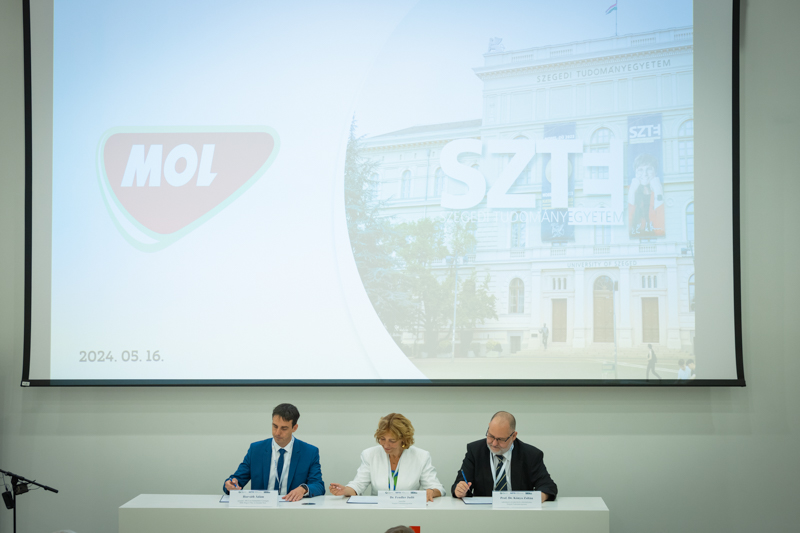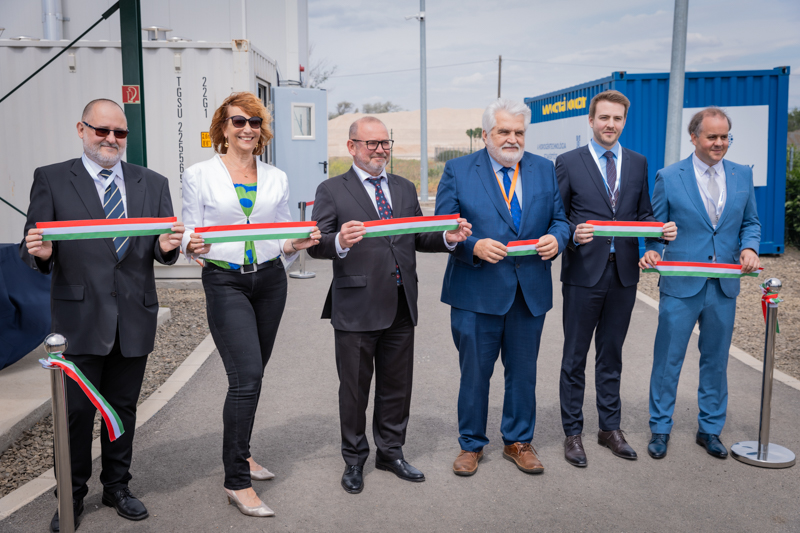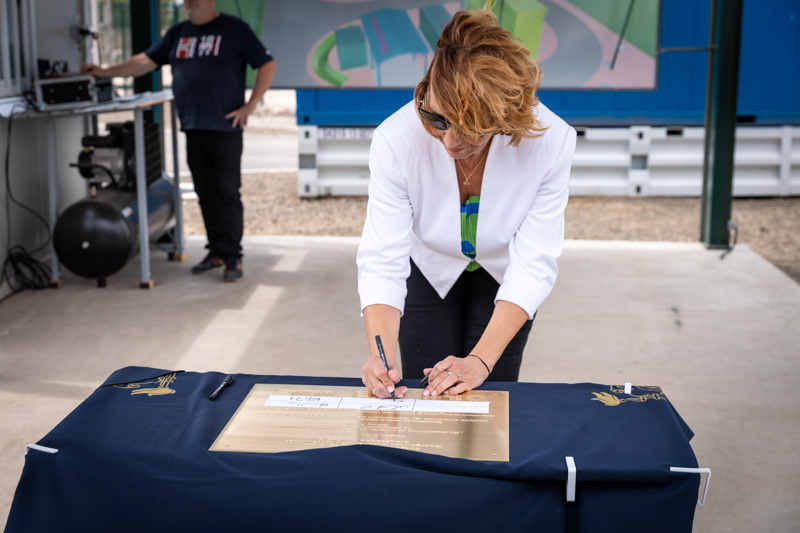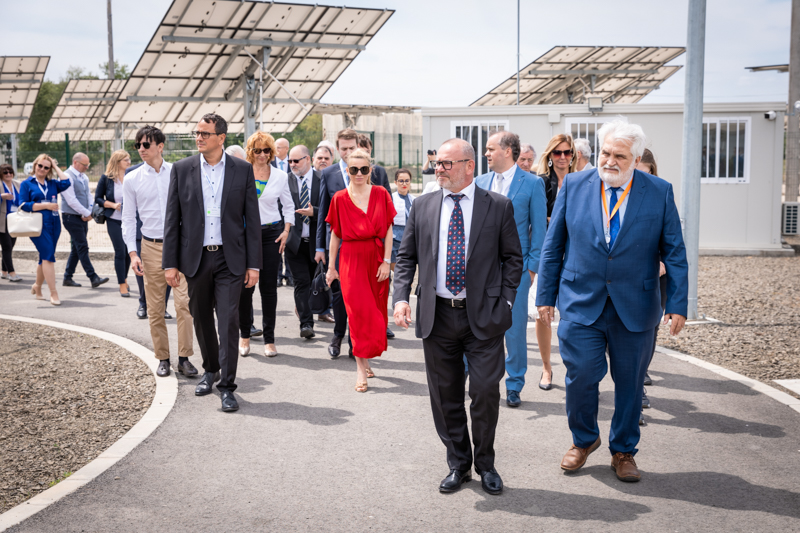

The big day of green energy at the University of Szeged - the Energy Innovation Test Station of SZTE was handed over
The new test station producing e-fuel is an important milestone in three objectives of the University of Szeged. It produces environmentally sustainable green energy; in cooperation with economic partners, it takes SZTE laboratory research to the threshold of industrial use; and its creation was helped by the forward-looking interdisciplinary approach of the university.
In the Science Park of the University of Szeged, after several years of development work, the Energy Innovation Test Station (EIT) of SZTE was ceremoniously handed over. At the ceremony held in the nearby conference hall of ELI ALPS, Prof. Dr. Zoltán Kónya, vice-rector for science and innovation at SZTE, and Prof. Dr. Gábor Szabó, chairman of the board of trustees of the University of Szeged Foundation, welcomed the energy industry partners and policy representatives, including Minister of Energy Csaba Lantos and László Bódis, deputy state secretary for innovation.
From the lab to industrial use
The SZTE EIT is a milestone in several important objectives of the university. It is a significant success, said Prof. Dr. Zoltán Kónya, that in its green transition program, the university implemented a semi-factory-kind station based on its own laboratory research results. These devices provide the entire value chain of green energy production and conversion, from the production of electricity from solar energy through energy conversion technologies to the production of e-fuel.

Prof. Dr. Zoltán Kónya, vice-rector for science and innovation at SZTE. Photo: Ádám Kovács-Jerney
SZTE's Energy Innovation Test Station also embodies the university's goal to bring the energy transition procedures included in domestic policy strategies to the threshold of industrial implementation in cooperation with the market players of the green economy. SZTE carries out the production and validation of e-fuel in a joint project with Széchenyi István University and the Audi Hungária car factory, and MOL is also interested in the results of the test station. Prof. Dr. Zoltán Kónya said that the EIT is also looking for partners; since its equipment can be replaced individually, partners can also bring their self-developed technologies for testing. In this way, the facility can even cover the costs of its own maintenance. According to Prof. Dr. Zoltán Kónya, the test station is also outstanding at the European level, and there is already international interest in it.
The SZTE Energy Innovation Test Station is also a symbolic success of the approach that created the IKIKK Center of Excellence of the University of Szeged for the sake of interdisciplinary research. Prof. Dr. Zoltán Kónya recalled: the whole project started when Dr. Csaba Janáky told him 4 years ago that there could be market demand for sustainable energy conversion technologies, such as water splitting. The SZTE IKIKK provided a framework and support for the implementation of the idea, ensuring the cooperation of several scientific fields for the design, development, and feasibility studies of the final products.
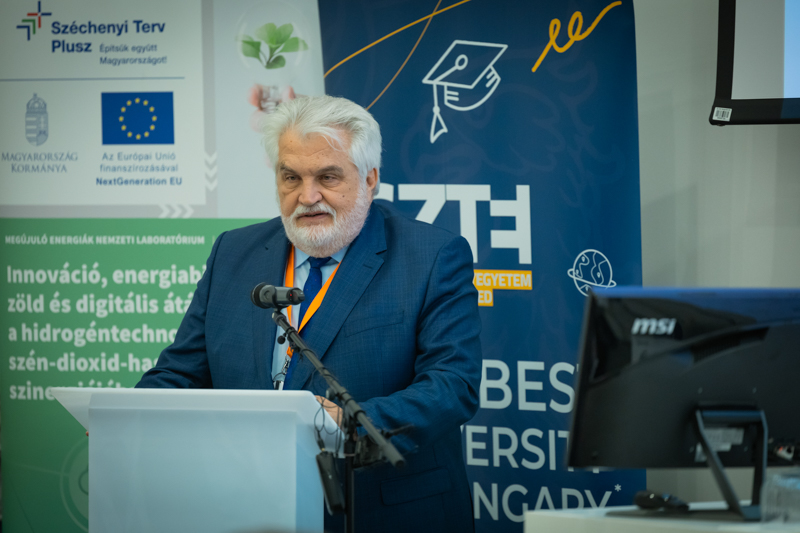
Prof. Dr. Gábor Szabó, chairman of the board of trustees of the University of Szeged Foundation. Photo: Ádám Kovács-Jerney
The initiator of the interdisciplinary approach in Szeged, Prof. Dr. Gábor Szabó, already as the former rector of the university drew attention to the fact that in the new science, the frameworks of traditional subjects lose their importance. "Nature does not know textbooks and physics," said the Széchenyi Prize-winning laser physicist, who believes that solutions to humanity's most challenging issues must be sought by synthesizing knowledge from several fields. New questions can no longer be formulated with the logic of basic research, but in a “mission-based" way, starting from the problems to be solved. Prof. Dr. Gábor Szabó recalled that the chemistry professor of the University of Szeged, Imre Kiricsi, who passed away in 2010, recognized very early on that the fields of physics and chemistry were merging, and new results were brought about by a combined approach.
 |
| The Energy Innovation Test Station of SZTE was handed over. GALLERY - Photos: Ádám Kovács-Jerney |
In the spirit of the János Neumann Program
At the event, Energy Minister Csaba Lantos praised the achievements of the Szeged research agglomeration, the University of Szeged, the ELI ALPS Laser Center, the Szeged Biological Research Center, and the SZTE Science Park in recent years. The minister explained that in mitigating the effects of global warming, it cannot be expected that the developed world can force developing countries to self-limit fossil energy production after 200 years of environmental pollution. Therefore, the reduction of greenhouse gas emissions requires the solutions of science, and new research that leaves the laboratory and reaches industrial testing. Csaba Lantos called it exemplary how the University of Szeged implemented the station for the production of e-fuel together with industrial and political partners.

Minister of Energy Csaba Lantos. Photo: Ádám Kovács-Jerney
Csaba Lantos reminded that the European Union causes 7% of the total greenhouse emissions, and Hungary only 0.15%. In the new National Energy and Climate Plan, Hungary undertakes a 50% emission reduction compared to the beginning of the 1990s, of which 37% has already been achieved. According to the minister, the sustainable and economical production of e-fuel will also play a role in the further reduction, which will increase the value of the SZTE test station.
Deputy State Secretary for Innovation László Bódis evaluated the SZTE Energetic Innovation Test Station according to the criteria of the János Neumann Program, which serves to connect universities and economic actors, calling it a model project of the program. The Széchenyi István University in Győr is present as a higher education partner in the project, MOL and Audi Hungária are market partners, the policy cooperation partner is the Ministry of Energy, and its financing is provided by the synergy of 3 large projects. (These are the projects named "Supplementation of the renewable electricity production of the Bükkábrány solar power plant with innovative energy storage technology", "National Laboratory of Renewable Energies" and "Development and validation of synthetic fuels in a large company environment”.) According to László Bódis, the model of the János Neumann Program also includes the fact that the EIT gives a response to an existing social need, translated into a specific industrial purpose, and this even generates income.

Deputy State Secretary for Innovation László Bódis. Photo: Ádám Kovács-Jerney
The sought-after products of a new industry: green hydrogen, e-fuel
After this, the initiator and manager of the new facility, Dr. Csaba Janáky, gave a lecture on sustainable energy storage methods and presented the units of SZTE's Energy Innovation Test Station. According to the Szeged researcher, decarbonization is necessary because the carbon dioxide concentration in the air is increasing at an accelerating rate: it has increased from 320 ppm in the 1980s to 425 ppm now, and tests of the Arctic ice sheet show that over the past 100 years the atmospheric CO2 concentration fluctuated between 200-300 ppm. Dr. Csaba Janáky considers it correct that the new energy concept supports technologies that work with electricity, and electrification but believes that batteries alone will not be sufficient for energy storage. Therefore, he sees the importance of so-called gravity energy storage, as well as carbon dioxide conversion, and hydrogen technology solutions, in larger quantities. For this, the test station in Szeged is needed to test the technology, approaching industry levels from the energy storage and conversion knowledge acquired in a small-scale laboratory.

Dr. Csaba Janáky, head of the SZTE Energy Innovation Test Station. Photo: Ádám Kovács-Jerney
About the development history of the test station, Dr. Csaba Janáky said that in 2023, the 50 kW small photovoltaic power plant (the solar park) was first built in the SZTE Science Park. The electricity obtained from this can also be used in a green way to power the electrochemical processes required for the production of final products. The two containers in which SZTE's self-designed equipment produces e-hydrogen by splitting water arrived at the test station in January 2024. The technology used to produce carbon monoxide from carbon dioxide on site is also located here.
A third container was put into operation in March 2024; this is where synthetic fuels are produced, which is done by the reaction of previously produced e-hydrogen and carbon dioxide or carbon monoxide. The synthetic raw material is similar to the crude oil mined in nature, gasoline, diesel, kerosene or even heavier oils can be made from it. (Participants of the ceremony also received a few milliliters of e-fuel in a small glass as a stylish gift).
The expanding role of SZTE
After the presentations, the cooperation agreement between the University of Szeged and MOL was signed, stating that they would jointly investigate the technological and economic aspects of the production of synthetic aircraft propellants (e-kerosene). The agreement was signed on behalf of SZTE by Chancellor Dr. Judit Fendler and Prof. Dr. Zoltán Kónya, vice-rector for science and innovation, and on behalf of MOL, Group DS New and Sustainable Businesses VP Ádám Horváth.

Dr. Judit Fendler, chancellor of SZTE. Photo: Ádám Kovács-Jerney
At the reception following the ceremony, Dr. Judit Fendler, chancellor of the University of Szeged, greeted the participants and partners of the realized project, expressing that SZTE is equally committed to sustainability efforts in its mission of education, research, healthcare, and social responsibility. According to Dr. Judit Fendler, the competencies of the university have been continuously expanded in recent years, and thanks to this, more and more partners in research and joint investment choose the University of Szeged. The chancellor of the SZTE stated that the University of Szeged was the first among higher education institutions in Hungary to create an interdisciplinary research and development center, where the disciplines work together for specific research and development programs. Finally, Dr. Judit Fendler thanked the participants and partners of the SZTE Energy Innovation Test Station project for their successful work.
About 120 guests who came to the ceremony visited the Energy Innovation Test Station of SZTE, where Csaba Lantos, László Bódis, Prof. Dr. Zoltán Kónya, Dr. Judit Fendler, Prof. Dr. Gábor Szabó and Dr. Csaba Janáky cut the inauguration ribbon of the facility, and then they signed the commemorative plaque prepared for the occasion. Afterwards, Dr. Csaba Janáky, Dr. Péter Sándor Tóth and Dr. András Sápi, members of the research group that created the test station, presented the solar park and the energy conversion containers to the guests.
Written by: Sándor Panek
Featured image: Prof. Dr. Zoltán Kónya, Dr. Judit Fendler, Csaba Lantos, Prof. Dr. Gábor Szabó, László Bódis and Dr. Csaba Janáky inaugurate the Energy Innovation Test Station of the University of Szeged in the SZTE Science Park. Photo: Ádám Kovács-Jerney







